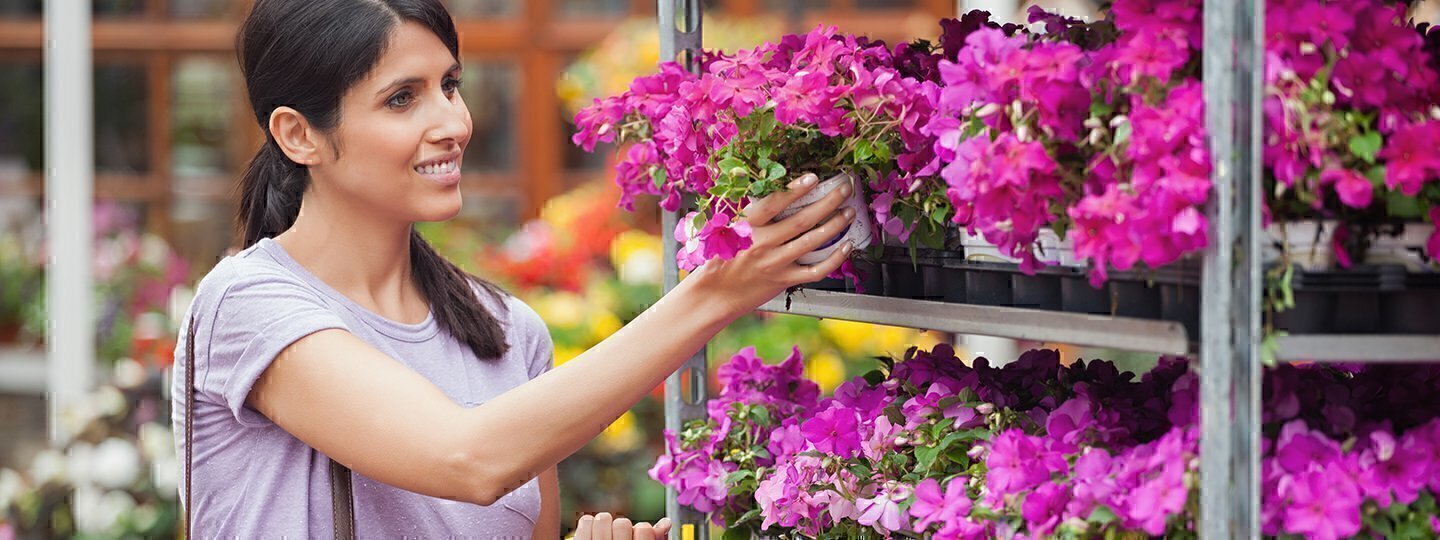Where to Shop for Plants
Last updated May 2024

Since most garden centers buy—rather than raise—most of what they sell, there is room for tremendous variation in buying standards and the quality of plants being sold. You’ll also want to shop at stores employ knowledgeable staff, offer broad selections of products, make things right when something goes wrong, and charge reasonable prices.
We surveyed area consumers and asked for their opinions on garden centers they frequent; the results are reported on our Ratings Tables.
Stores that Offer Sage Advice
Garden center staffers can offer invaluable advice on buying plants, including which ones grow best for the conditions in your yard and how to care for them.
Our Ratings Tables show how consumers we surveyed rated stores. We primarily surveyed Consumers’ Checkbook subscribers, but also invited other randomly selected consumers to participate. Our Ratings Tables list the stores that received 10 or more survey responses. Click here for more on our customer survey and other research methods.
The “advice” at several of the rated stores was judged “superior” by at least 80 percent of surveyed customers; by contrast, some others got similarly favorable ratings from fewer than 40 percent of respondents. The largest chains, including Home Depot and Lowe’s, scored, on average, lower than most other stores.
Stores that Offer the Best Plants
The quality of plants varies tremendously from store to store. Unlike nurseries, which grow plants, these days most retailers buy what they sell, and buying expertise and standards vary greatly. The care plants get after they reach the store is also important.
When inspecting plants, be sure they are “true to type”—that is, they look the way that species of plant is supposed to look. If they’re supposed to be symmetrical, dark green, or covered in purple flowers, make sure they are.
Learn what plants should look like by checking plant catalogs, gardening websites, and books, or by talking with experts at local government cooperative extension offices or Master Gardeners working for botanical gardens. Touring gardens can also educate you.
As you shop, check whether plants are in good condition, since healthier ones are more likely to survive, grow up looking better, and require less effort to maintain. You don’t want a plant that loses foliage or branches and becomes scraggly. Stressed plants can also attract insects and diseases, which can spread to neighboring healthy plants.
Some pointers to help you identify high-quality plants:
- Plants should not have dried out. Use a finger to check for moisture around the roots, avoid plants placed on hot pavement, and be sure their root balls are covered with soil, sawdust, or bark. Many plants—particularly broadleaf evergreens—should be protected from continuous direct sunlight.
- The root ball of “balled and burlapped” plants should not be cracked or loose, and dirt shouldn’t be torn away from the roots. Check that the ball moves as you gently tip the tree, but don’t rock the tree from side to side because that might separate the tree from the ball.
- Roots shouldn’t be brown, which means they’re dead. Also, be sure they aren’t “root bound,” which means they’ve outgrown their containers or become tightly wound around each other. This could eventually strangle the plant.
- Make sure plants’ root balls are large enough to sustain them: For deciduous trees the ball should be nine to 12 inches in diameter for each inch of trunk diameter; for evergreen trees it can be slightly smaller.
- Check the drainage holes of plant containers; excess white residue indicates over-fertilization.
- Examine trees and shrubs for weak and declining branches, scarring, pruning cuts not flush with the branch or trunk, dead wood, indications of disease or infestation, and holes.
- Make sure trees and shrubs have strong branches that grow out from the center.
- Check that foliage is not unnaturally yellowed, faded, bruised, or injured.
- Make sure a tree doesn’t have a “V” crotch; the tree may split in half as the tree grows.
- Look for signs of disease, such as browned or grayed areas, or spots on leaves or stems.
- Examine plants for insect damage, such as holes chewed in the edges of leaves or tunnels visible between leaf layers.
- During the growing season, make sure there is new growth (usually a lighter green) and that leaves are not wilted.
- When buying plants sold with bare roots (for example, most young fruit trees), check that the roots are not shriveled or dry.
- Check tags to see if plants were dug in the wild. The roots of wild-grown plants spread, and much of that material is lost when plants are dug up. Plants cultivated in nurseries, on the other hand, are likely to have their roots pruned several times during transplanting or otherwise contained during their development, forcing a more compact root system that can be dug up largely intact.
Our Ratings Tables report what many consumers thought of the quality of plants in stores they used. Most outlets of national chains Home Depot and Lowe’s scored low on this measure.

Stores that Offer Variety and Special Services
Both sophisticated gardeners and new plant parents may care as much about the availability of exotic specimens as plant health. Our Ratings Tables report scores from consumers on “variety.” But keep in mind this survey question might mean different things to different respondents, depending on which store they were rating. A garden center specializing in annuals might have been rated high for its wide selection of annuals, and not downgraded for a weak selection of shrubs or trees.
Many stores do more than just sell plants, also providing landscaping advice, doing planting, building retaining walls, and more.
Stores with Customer-Friendly Guarantees and Return Policies
The type of guarantees a store offers can also be a hallmark of quality. Those with good guarantees probably believe their plants are healthy—and will compensate you if they aren’t. Guarantees vary in length, percentage of the price covered, whether any planting costs are covered, and other factors. In general, you get a broader guarantee if the store does the planting for you.
Although many plant deaths occur from improper planting or care post-purchase, surprisingly, many garden centers offer strong guarantees.
We asked customers to rate garden centers on “reliability (standing behind products, delivering on time, etc.).” Our Ratings Tables show the percentage of each store’s surveyed customers who rated it “superior”—a good indication of which stores are most likely to replace defective plants.
To protect yourself from a bad buy, get a receipt that includes: name, size, and grade of each plant; number purchased; date; price of each plant; and guarantee (duration, whether it covers costs of delivery and planting, percentage of cost covered, what you must do to keep the guarantee in force).
If you plan to have the plants delivered, the receipt should indicate delivery date, delivery charge (if any), and planting charges (if applicable).
Have the store tag any delivered plants. For major purchases, take pictures of your selections; otherwise, it may be hard to argue that the store has sent you the wrong rosebush or broccoli rabe plant.
Obtain the following information on each plant you buy:
- Latin name and common name of the plant—necessary for obtaining advice on the plant months or years later
- How to plant it—size and depth of hole, whether to fertilize and stake, recommended soil for planting hole
- Desirable amount of sun and specifications for drainage
- Proper care—pruning, feeding, and spraying requirements
- Whether you can expect fruit or flowers


